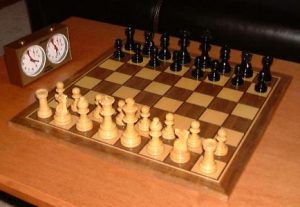For centuries, chess has been considered the ultimate test of strategic thought. This board game was thought of as the “royal game” for years because it held a special fascination for the nobility and the upper class in many countries. Over the course of the 20th century, chess has reached a much wider audience across class lines and has become a popular subject of worldwide tournaments. Chess has become valued as a means of developing artificial intelligence, and chess has become a popular subject in film and television, including the Netflix series The Queen’s Gambit. Chess’ development is a long and interesting history, and Central Rappahannock Regional Library’s collection has several guides that can help improve your skills in this great game.
Beginner Openings: The History and Origins of Chess
Chess is such an ancient game that its origins cannot be tracked to one specific person or an exact time. The earliest ancestor of modern chess is believed to be chaturanga, a board game thought to have originated sometime in the sixth century A.D. in the north of India. Many of the rules and meanings of markings on the board in this ancestor of chess have been lost to time, forcing “modern chaturanga” to be retro-engineered from chess rules. Chess first evolved into its modern form in Persia, where the game developed a ruleset and piece-naming conventions that resembled the modern version. Persians were the first to develop the concepts of ”check” and “checkmate,” and the European piece names for chess are derived from the Persian ones, such as shah (king) and rukh (rook). The Persian version of chess spread around the world and arrived in Europe by the ninth century, most likely through Islamic Spain. Once in Europe, tactics and rulesets began to develop further, and pieces such as the bishop and queen received their modern board movements.
As European chess emerged, tactical guides to playing the game began to appear. Earlier guides to chess from Persia and the Islamic world did not provide much guidance in regards to opening moves; one of the first of these was published by Ruy Lopez, a Spanish priest, in 1561. The change in appearance of chess pieces into their now typical forms happened even later, when the Staunton chess set was created in 1849. The creation of these standardized chess pieces made it much easier to organize tournaments with people from different areas and even nations, who previously used different styles for their chess pieces. Large chess tournaments drew an increasing number of competitors as a result, and guides and strategies became further codified and developed.
Develop Your Strategies: Guides to Chess
The library offers several guides to chess in our collection. Our Kanopy subscription allows our customers access to many useful videos on chess strategies and theory. A simple search in the online catalog reveals we have 33 streaming videos on chess, but some of these are more useful as playing guides than others. A Cascade of Short, Brutal Chess Games! demonstrates several traps rookie chess players can fall into and the best ways to avoid them. Must-Know Tactical Patterns in Chess teaches how to use tactics, such as decoys and discovered attacks, so you can outmaneuver your opponent. Mathematics and Chess explains how chess is connected to skill in mathematics and how you can solve classic chess puzzles with math. Finally, Kings and Pawns in Next-Level Endgames explores strategies you can use in chess endgames to checkmate your opponent or create a draw.
There are many books in CRRL’s collection that you can also use to enhance your chess skills as well. Learn to Play Chess Like a Boss is a guide written with beginning players in mind and provides information on the tactical strengths and weaknesses of all the pieces and moves you can make at any stage of the game. The Improving Chess Thinker explains the thought patterns of chess players at different skill levels and how you can progress your own skills and tactical thinking methods. Chess Training Pocket Book teaches how you can win games, position by position. And, Bobby Fischer Teaches Chess allows players to learn the insights of one of the game’s great grandmasters.
CRRL’s collection also features books and other media on the history and great players of chess. Bobby Fischer Goes to War details the famed 1972 game where Fischer defeated his Soviet rival Boris Spassky--and the months of mind games and hype that preceded the game. Deep Thinking is former chess champion Garry Kasparov’s exploration of how chess can be used to enhance machine intelligence and why human/computer competition is needed to further evolve the game. Legendary Teachers Who Transformed Chess offers a look at historically important players whose strategies continue to be utilized today. And, Chess Heroes of the Romantic Age teaches about the long-lived Romantic era of chess, and some of the most important players from its three centuries.
Endgame Principles: Chess in Modern Culture
As an intricate test of skill and tactical reasoning, chess has become valued as a tool for developing and enhancing computer intelligence. Interest in a chess-playing machine predates the development of modern computers, as the Turk, a chess-playing machine, was first shown in 1770. The Turk was actually a mechanical illusion; it was operated by a chess master hiding within the box but had enough clockwork and gears to convince an observer that it was an automaton. The first true computer chess program would be developed in 1947 by Alan Turing, the great pioneer of artificial intelligence. Turing’s program could only analyze one side’s move ahead, but computer technology evolved rapidly, and the first fully functional computer chess program was created in 1962. As computers became more powerful, their artificial intelligence increased to the point that Garry Kasparov battled IBM’s computer Deep Blue in 1996 and became the first chess world champion to lose a game versus a computer program. Kasparov’s losses to Deep Blue would trigger a wave of massive interest in AI and data that would grow ever more sophisticated and inspire many of the algorithms and systems that sustain our lives today.
As chess tournaments have become more high profile, films and TV shows about chess players and games have become increasingly popular. Films such as Pawn Sacrifice, a dramatization of Bobby Fischer and Boris Spassky’s famous game, and Queen of Katwe, the story of a teenager from Uganda who became an international chess champion, are based on true stories. Others, such as The Queen’s Gambit, based on a 1983 novel by Walter Tevis, are fictional.
The Queen’s Gambit in particular is associated with driving the increased popularity of chess in 2020, but there is another likely reason as well. Just as tech advances have driven the development of computer chess programs, the pandemic has transformed many chess tournaments into online play. The ability to easily play against competitors from across the country or around the world will further drive the growth of chess, and computer chess as a fascination will long outlive the pandemic. No matter how vast the competitive chess scene grows, CRRL offers great resources to help you get in and stay in the game!




